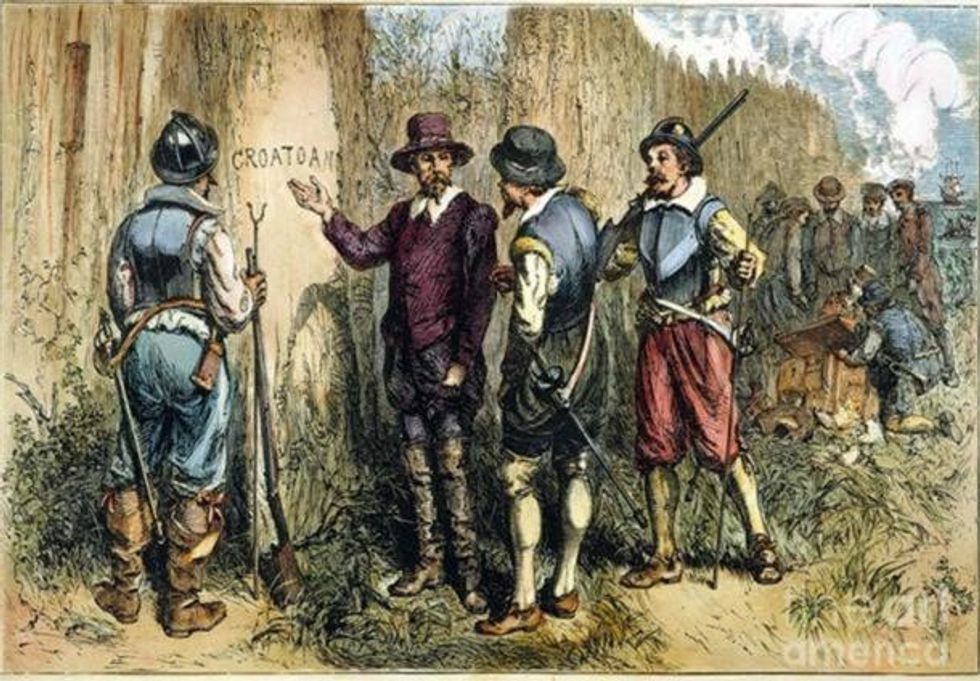Following his half-brother's death, Raleigh was granted a royal charter by Queen Elizabeth I to explore and colonize "any remote, heathen, and barbarous lands, countries, or territories, not actually possessed of any Christian Prince or inhabited by Christian people." In return, he would provide one-fifth of the gold and silver mined from that land. It was intended by Raleigh and the queen that the venture would provide riches from the New World and a base from which to send privateers to raids the Spanish treasure fleets.
Raleigh never visited North America. Instead, he leads expeditions to South America in 1595 and 1617 in search of the golden city, El Dorado. Needless to say, the guy never found it. But he sent others to 1585 to establish the Roanoke Colony. Today, it is known as the Lost Colony.
The first expedition to North America was a bit rocky. The small fleet of ships was separated by a storm of the coast of Portugal, eventually meeting up again on Puerto Rico. One ship did reach the Outer Banks and the north end of Roanoke Island. Just over 100 men settled building a small fort but were lacking in food and other supplies. When there was no sign of the promised relief fleet, many took up the offer to return to England from Sir Francis Drake, who was returning from a successful raid in the Caribbean. Those who returned introduced England to tobacco, maize, and potatoes. The relief fleet turned shortly after Drake's departure, finding the colony abandoned. The relief fleet returned to England but left 15 men behind to keep up their English presence and to keep Raleigh's claim on Roanoke.
A second expedition launched in 1587 to again establish a settlement on Roanoke Island. This time, the settlers were more diverse, including entire families who were to be governed by John White. He re-established relations with the Croatans and other local Native Americans when the colonists arrived again on Roanoke. Soon after, White was persuaded by the colonists to return to England and explain their desperate situation. The colonists were lacking in food, supplies, and feared to the anger of the nearby tribes.
White left behind 115 colonists, the men and women who made the Atlantic crossing and his new granddaughter, Virginia Dare, who was the first English child born in the Americas. White promised to return in a year but a series of delays turned that year in three.
White returned to the colony on August 18, 1590, his granddaughter's third birthday. But when he arrived, he found it deserted with no trace of a struggle or battle or the 90 men, 17 women, and 11 children he left behind. What he did find was the word "CROATAN" and the letters C-R-O carved into nearby trees. All of the houses and forts had been dismantled meaning the colonists were not hurried out of their home. He told his people before leaving to carve a Maltese cross into the tree to signify that they had been forced to leave. He assumed the word carved into the tree meant they had been moved to Croatan Island, today known as Hatteras Island, but he was unable to conduct a search due to a storm. He returned to England, hopeful that his family was still alive. In a letter to Richard Hakluyt, he expressed that "he must hand over the fate of the colonists and his family to the merciful help of the Almighty, whom I most humbly beseech to help and comfort them."
We still are not entirely sure what happened to the colonists of Roanoke. They could have died of starvation. They could have fought with the nearby tribes and were taken as prisoners. They could have sought shelter with a nearby tribe as well. There are many theories as to what happened to the colony and hopefully one day we will have answers. For now, Roanoke Island keeps it name, the Lost Colony of Roanoke.

















